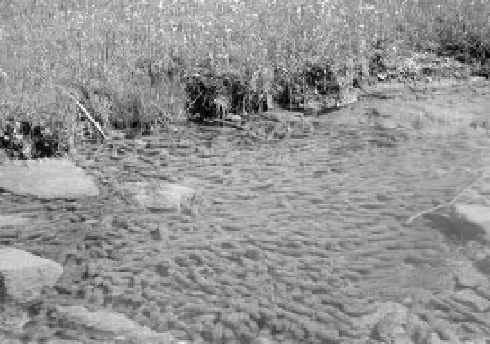Geoscience Reference
In-Depth Information
(
Ranunculus l abellaris
), pepperwort (
Marsilea
vestita
), and water smartweed (
Polygonum
amphibium
).
Many plants found in wetlands also grow in
dry, upland settings. These plants are opportun-
istic; they rapidly occupy disturbed sites, such
as where receding water has exposed mudl ats.
Common examples are barnyardgrass (
Echino-
chloa muricata
), common plantain (
Plantago
major
), and foxtail barley (
Hordeum jubatum
),
which are just as likely to be found in wetlands
as on uplands (Fig. 6-31).
6.3 Indicator categories
Given that some plants have specii c wetland
preferences, the occurrence of these plants may
be a key factor for identifying wetland habitats.
In the United States, hydrophytes are used for
regulatory purposes to dei ne wetlands. These
plants are listed by the U.S. Fish and Wildlife
Service, and macrophytes (vascular plants) are
placed into i ve categories (Table 6-1). Mosses
and algae are not included on the list. It should
be noted that a plant's wetland status may
change from region to region. For example, the
slash pine (
Pinus elliottii
) is considered FACW
in the southeast and FAC in the southern plains
of the United States, but is listed as UPL in the
Caribbean region.
Figure 6-28.
Coontail (
Ceratophyllum demersum
),
looks like a tangled pile of ropes in this shallow,
spring-fed stream. In alkaline (hard) water, coontail
becomes encrusted with lime, which makes the plants
relatively stiff and brittle (Lahring 2003). Photo by J.S.
Aber; Turner Falls, Oklahoma, United States.
Figure 6-29.
Old Wives Lake, Saskatchewan, Canada (see Color Plate 6-29). Notice distinct and continuous
vegetation zones marking high shorelines along the margin of the lake. Kite aerial photograph by J.S. Aber and
S.W. Aber.







